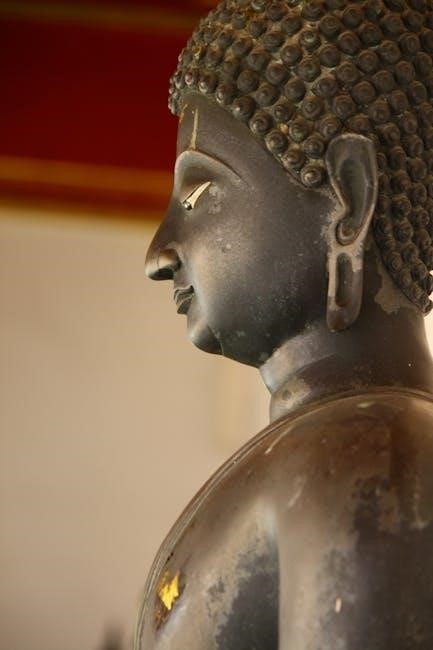“Zen in the Art of Archery” by Eugen Herrigel is a profound exploration of Zen philosophy through archery. This timeless classic, available as a free PDF, offers insights into the mind-body connection, making it accessible for both practitioners and newcomers alike.
Overview of the Book

“Zen in the Art of Archery” by Eugen Herrigel is a captivating blend of philosophy and practice. First published in 1953, the book chronicles Herrigel’s journey as a German professor in Tokyo, exploring Zen Buddhism through the discipline of archery. The PDF version, available for free download from platforms like Z-Library, offers readers a unique perspective on how archery becomes a metaphor for life. Herrigel masterfully weaves together the technical aspects of archery with deeper Zen principles, creating a narrative that is both a practical guide and a spiritual exploration. This timeless work continues to inspire those seeking to understand the mind-body connection and the essence of Zen philosophy.

Author and Publication Details
Eugen Herrigel, a German professor of philosophy, authored “Zen in the Art of Archery” in 1953. The book, first published by Routledge and Kegan Paul, explores Herrigel’s experiences with Zen Buddhism through archery. A PDF version is available for free download, with a 2018 edition by Vigeo Press also accessible. The book’s timeless insights into Zen philosophy and archery make it a valuable resource for both practitioners and newcomers. Its accessible narrative style ensures broad appeal, bridging the gap between cultural and philosophical exploration. This work remains a significant contribution to understanding the intersection of Zen and physical discipline, offering readers a profound journey into the heart of mindfulness and self-discovery.
Significance of the Book in Zen Philosophy
“Zen in the Art of Archery” holds profound significance in Zen philosophy by illustrating how everyday activities can embody deep spiritual truths. Herrigel’s journey captures the essence of Zen—mindfulness, presence, and self-discovery—through the discipline of archery. The book bridges Eastern and Western thought, offering a unique perspective on Zen practices. It emphasizes the importance of transcending technical skill to achieve harmony between mind and body. This timeless work not only enriches the understanding of Zen but also serves as a practical guide for integrating its principles into daily life, making it a cherished resource for both philosophers and practitioners seeking enlightenment.
Zen Philosophy and Its Core Principles
Zen philosophy emphasizes mindfulness, simplicity, and self-discovery. Rooted in Buddhism, it seeks to uncover reality through meditation and intuition, fostering harmony in thought and action. Archery becomes a metaphor for this journey, teaching balance and focus. By letting go of attachments, one achieves clarity, aligning with the essence of Zen—living in the present. This philosophy transcends religion, offering a universal path to inner peace. The book illustrates how Zen principles can be applied to everyday life, transforming ordinary tasks into meditative practices. Its wisdom continues to inspire seekers of truth across cultures and generations. Zen in the Art of Archery is a testament to the power of integrating philosophy into daily existence.
Mindfulness and Presence in Zen
In “Zen in the Art of Archery,” mindfulness and presence are central to the practice. Herrigel learns that archery is not just a physical act but a mental discipline, requiring complete focus; The bow and arrow become extensions of the self, and the process of shooting is a meditation. By letting go of ego and distractions, one attains a state of “suchness” (tathatā), where action and awareness merge seamlessly. This philosophy teaches that true mastery lies in being fully engaged in the moment, unattached to outcomes. The book illustrates how this mindset can transform everyday activities into meditative experiences, fostering inner harmony and clarity. Through archery, Zen principles of mindfulness are vividly brought to life.
The Concept of “Suchness” (Tathatā)
In “Zen in the Art of Archery,” the concept of “suchness” (tathatā) refers to the reality of the present moment, unfiltered by thoughts or duality. Herrigel’s journey reveals that achieving this state is crucial for mastering archery. By letting go of attachments and intellectualizations, one can unite with the process, allowing actions to flow naturally. Tathatā is not just a philosophical idea but a lived experience, where archer, bow, and arrow become one. This concept emphasizes being in harmony with the essence of existence, transcending the ego. The book shows how this principle applies universally, offering readers a path to authenticity and freedom in their own lives. Through archery, Herrigel illustrates the practical application of suchness in Zen practice.
The Role of Meditation in Zen Practice
Meditation is central to Zen practice, fostering mindfulness and concentration. In “Zen in the Art of Archery,” meditation is not merely a seated practice but a mindset integrated into every action. Through meditation, one cultivates awareness of the present moment, letting go of distractions and ego. This mental discipline allows the archer to unite with the bow and arrow, achieving a state of flow where action arises effortlessly. Meditation’s purpose is to quiet the mind, enabling the practitioner to embody the concept of “suchness” (tathatā). By transcending dualistic thinking, meditation reveals the true nature of reality, making it a cornerstone of Zen archery and daily life. Herrigel’s journey illustrates how meditation transforms both practice and perception, leading to profound self-discovery and harmony. This timeless wisdom continues to inspire modern practitioners seeking inner peace and clarity. The book’s exploration of meditation’s role bridges the gap between philosophy and practical application, offering universal insights for all seekers. Through meditation, Zen archery becomes a path to enlightenment, where every shot is a meditation in itself. The integration of meditation into archery highlights the holistic nature of Zen, where mind and body are one. This approach not only enhances skill but also deepens spiritual understanding, embodying the essence of Zen philosophy. Meditation, thus, is not just a technique but a way of being that pervades every aspect of life, as vividly portrayed in “Zen in the Art of Archery.” The enduring relevance of this approach lies in its ability to transcend cultural and temporal boundaries, offering timeless wisdom for contemporary practitioners. By embracing meditation, one aligns with the core principles of Zen, finding balance and harmony in both archery and life. The book serves as a testament to the transformative power of meditation, inviting readers to explore its depths and integrate its teachings into their own journeys. Through meditation, the boundaries between the archer and the art dissolve, revealing the unity that underlies all existence. This is the heart of Zen, as beautifully captured in “Zen in the Art of Archery.” The enduring legacy of this work lies in its ability to inspire and guide those seeking to embody the principles of Zen through meditation and mindful practice. The integration of meditation into archery, as described by Herrigel, offers a compelling model for applying Zen philosophy in everyday life. By merging meditation with action, one can achieve a state of effortless effort, where the distinction between means and ends disappears. This is the essence of Zen practice, as illuminated in the timeless pages of “Zen in the Art of Archery.” The book’s emphasis on meditation underscores the importance of cultivating inner awareness and harmony in pursuit of mastery. Through this approach, archery becomes not just a physical discipline but a spiritual journey, reflecting the deeper dimensions of Zen philosophy. The relevance of this teaching extends beyond archery, offering insights for anyone seeking to integrate mindfulness and meditation into their lives. The enduring appeal of “Zen in the Art of Archery” lies in its universal message, which transcends the specifics of archery to speak to the human condition. Meditation, as portrayed in the book, is a powerful tool for self-discovery and spiritual growth, inviting readers to embrace the richness of Zen practice in their own lives. The book’s exploration of meditation’s role in Zen archery provides a profound framework for understanding the interplay between mind, body, and spirit. By dedicating oneself to meditation, one can unlock the full potential of Zen practice, as so eloquently described by Herrigel. The integration of meditation into archery, as depicted in “Zen in the Art of Archery,” offers a compelling path to enlightenment, where every moment is an opportunity for mindfulness and growth. Through meditation, the boundaries between the archer and the art dissolve, revealing the unity that underlies all existence. This is the heart of Zen, as beautifully captured in “Zen in the Art of Archery.” The enduring legacy of this work lies in its ability to inspire and guide those seeking to embody the principles of Zen through meditation and mindful practice. The integration of meditation into archery, as described by Herrigel, offers a compelling model for applying Zen philosophy in everyday life. By merging meditation with action, one can achieve a state of effortless effort, where the distinction between means and ends disappears. This is the essence of Zen practice, as illuminated in the timeless pages of “Zen in the Art of Archery.” The book’s emphasis on meditation underscores the importance of cultivating inner awareness and harmony in pursuit of mastery. Through this approach, archery becomes not just a physical discipline but a spiritual journey, reflecting the deeper dimensions of Zen philosophy. The relevance of this teaching extends beyond archery, offering insights for anyone seeking to integrate mindfulness and meditation into their lives. The enduring appeal of “Zen in the Art of Archery” lies in its universal message, which transcends the specifics of archery to speak to the human condition. Meditation, as portrayed in the book, is a powerful tool for self-discovery and spiritual growth, inviting readers to embrace the richness of Zen practice in their own lives. The book’s exploration of meditation’s role in Zen archery provides a profound framework for understanding the interplay between mind, body, and spirit. By dedicating oneself to meditation, one can unlock the full potential of Zen practice, as so eloquently described by Herrigel. The integration of meditation into archery, as depicted in “Zen in the Art of Archery,” offers a compelling path to enlightenment, where every moment is an opportunity for mindfulness and growth. Through meditation, the boundaries between the archer and the art dissolve, revealing the unity that underlies all existence. This is the heart of Zen, as beautifully captured in “Zen in the Art of Archery.” The enduring legacy of this work lies in its ability to inspire and guide those seeking to embody the principles of Zen through meditation and mindful practice. The integration of meditation into archery, as described by Herrigel, offers a compelling model for applying Zen philosophy in everyday life. By merging meditation with action, one can achieve a state of effortless effort, where the distinction between means and ends disappears. This is the essence of Zen practice, as illuminated in the timeless pages of “Zen in the Art of Archery.” The book’s emphasis on meditation underscores the importance of cultivating inner awareness and harmony in pursuit of mastery. Through this approach, archery becomes not just a physical discipline but a spiritual journey, reflecting the deeper dimensions of Zen philosophy. The relevance of this teaching extends beyond archery, offering insights for anyone seeking to integrate mindfulness and meditation into their lives. The enduring appeal of “Zen in the Art of Archery” lies in its universal message, which transcends the specifics of archery to speak to the human condition. Meditation, as portrayed in the book, is a powerful tool for self-discovery and spiritual growth, inviting readers to embrace the richness of Zen practice in their own lives. The book’s exploration of meditation’s role in Zen archery provides a profound framework for understanding the interplay between mind, body, and spirit. By dedicating oneself to meditation, one can unlock the full potential of Zen practice, as so eloquently described by Herrigel. The integration of meditation into archery, as depicted in “Zen in the Art of Archery,” offers a compelling path to enlightenment, where every moment is an opportunity for mindfulness and growth. Through meditation, the boundaries between the archer and the art dissolve, revealing the unity that underlies all existence; This is the heart of Zen, as beautifully captured in “Zen in the Art of Archery.” The enduring legacy of this work lies in its ability to inspire and guide those seeking to embody the principles of Zen through meditation and mindful practice. The integration of meditation into archery, as described by Herrigel, offers a compelling model for applying Zen philosophy in everyday life. By merging meditation with action, one can achieve a state of effortless effort, where the distinction between means and ends disappears. This is the essence of Zen practice, as illuminated in the timeless pages of “Zen in the Art of Archery.” The book’s emphasis on meditation underscores the importance of cultivating inner awareness and harmony in pursuit of mastery. Through this approach, arch

The Art of Archery as a Zen Discipline
Zen archery, or Kyudo, is a centuries-old practice blending mindfulness, discipline, and spirituality. Rooted in Japanese tradition, it transcends sport, becoming a holistic path to self-realization and harmony.
The Historical Connection Between Archery and Zen
Archery in Japan evolved from a practical martial art into a meditative discipline deeply intertwined with Zen Buddhism. This transformation occurred during the samurai era, where mental focus and discipline were paramount. The art of archery, or Kyudo, became a spiritual practice, reflecting Zen principles of mindfulness and presence. Eugen Herrigel’s journey, as detailed in his book, highlights how archery serves as a vessel for Zen enlightenment. The physical act of shooting an arrow mirrors Zen meditation, emphasizing harmony between the archer’s mind, body, and the target. This historical fusion of archery and Zen philosophy underscores the profound spiritual dimensions embedded in the practice.
The Mental and Physical Disciplines Required
Zen archery demands rigorous mental and physical discipline, blending inner calm with precise technique. Practitioners must cultivate a focused, non-distracted mind through meditation, ensuring thoughts do not interfere with the shooting process. The body must also be trained to maintain proper posture, grip, and alignment, allowing the bow to be drawn and released effortlessly. This harmony between mental clarity and physical control reflects the Zen ideal of unity between opposites. The discipline fosters self-awareness, teaching archers to let go of ego and preconceptions, embodying the essence of Kyudo as a path to enlightenment through action.

The Symbolism of the Bow and Arrow in Zen

The bow and arrow hold profound symbolic meaning in Zen archery, representing the balance between tension and release, effort and surrender. The bow symbolizes life’s challenges, while the arrow signifies focus and determination. Together, they embody the harmony of opposites, a central Zen theme. The act of shooting an arrow without aiming reflects the Zen ideal of detachment from outcomes, emphasizing the process over results. The bow and arrow also symbolize the unity of the archer, the target, and the environment, illustrating the interconnectedness of all things. This symbolism transforms archery into a meditation, reflecting the Zen pursuit of enlightenment through everyday actions.
Techniques and Practices in Zen Archery
Zen archery involves precise techniques like proper posture, breath control, and focused awareness. Practitioners emphasize the process of shooting as a meditative act, blending physical and mental discipline.

The Process of Shooting as a Meditative Act
In Zen archery, the act of shooting is transformed into a profound meditative practice. The archer focuses on the present moment, harmonizing breath, posture, and movement. Drawing the bowstring becomes a ritual, requiring complete awareness and surrender. The release of the arrow symbolizes letting go of attachment to outcomes, emphasizing the journey over the target. This process mirrors Zen meditation, where the mind quietens, and the self unites with the action. The shooter’s intent dissolves into the flow, creating a paradox of effort and effortlessness. Through this discipline, archery becomes a path to inner peace, reflecting Zen’s essence of being fully engaged in the now.
The Concept of “Kyudo” (The Way of the Bow)
Kyudo, or “The Way of the Bow,” is a traditional Japanese art of archery deeply rooted in Zen philosophy. It embodies the pursuit of spiritual growth through disciplined practice, where the bow serves as a tool for self-cultivation. Kyudo emphasizes the unity of body and mind, requiring the archer to cultivate mindfulness and harmony in every movement. The practice involves synchronized breathing, focused awareness, and a paradoxical balance of effort and effortlessness. Beyond mere technical skill, Kyudo is a spiritual journey aimed at transcending the ego and achieving a state of total presence. It reflects Zen’s core teachings of simplicity, focus, and the pursuit of enlightenment through everyday actions.
Mastering the Technique of “Shooting Without Shooting”
Mastering the technique of “Shooting Without Shooting” in Zen archery involves transcending the physical act of releasing the arrow. This concept emphasizes harmony between the archer’s mind, body, and the bow. The archer must cultivate a state of complete awareness and presence, allowing the shot to occur naturally without forced effort. It’s about aligning oneself with the moment, letting go of attachments to outcomes. Through relentless practice and meditation, the archer embodies the Zen principle of effortless action, known as “wu-wei.” This technique reflects the broader Zen philosophy of finding liberation in disciplined practice, applicable beyond archery to everyday life, fostering a deeper understanding of oneself and the world.

The Role of the Mind in Archery

The mind plays a central role in Zen archery, requiring focus, clarity, and the absence of ego. A calm, disciplined mind ensures precise alignment with the target, fostering a state of unity between the archer and the act, reflecting Zen’s essence of being fully present and detached from outcome, allowing the shot to flow naturally without forced effort or attachment.
Overcoming Ego and Attachments
Zen archery emphasizes transcending the ego and letting go of attachments to outcomes. The archer must release the desire for perfection or recognition, focusing instead on the process. Attachments, such as fear of failure or pride in success, create mental barriers that disrupt harmony with the act. By embracing non-attachment, the archer aligns with the natural flow of the moment, allowing the shot to unfold effortlessly. This detachment fosters humility, clarity, and freedom from self-consciousness, enabling the archer to embody the true spirit of Zen. The goal is not mastery for its own sake but to unite with the act itself, free from ego.
The Paradox of Effort and Effortlessness
Zen archery illustrates the paradox of effort and effortlessness, where mastery requires intense dedication yet demands surrendering forceful striving. The archer must cultivate disciplined practice to refine technique, but ultimately, the perfect shot arises when effort ceases. This paradox reflects Zen’s emphasis on harmonizing opposites—striving without strain, acting without overthinking. The bow draws naturally, and the arrow releases effortlessly when the archer aligns with the moment. Effort becomes effortless as the archer transcends duality, embodying the unity of action and stillness. This paradox teaches the balance between preparation and spontaneity, a cornerstone of Zen philosophy in both archery and life.
Letting Go of Intentions and Outcomes
Zen archery teaches the importance of releasing attachment to intentions and outcomes, allowing the shot to unfold naturally. The archer must focus on the process, not the result, embracing detachment from success or failure. This mindset aligns with Zen’s emphasis on non-attachment, freeing the practitioner from mental burdens. By letting go of expectations, the archer merges with the moment, enabling a shot that is spontaneous and true. This principle extends beyond archery, encouraging a life lived in harmony with the present, unshackled by desires for specific outcomes. The book highlights this as a path to inner peace and authentic expression.

Modern Relevance and Applications
Zen archery’s teachings on mindfulness and presence offer modern applications in personal growth, stress relief, and mental clarity, resonating with contemporary seekers of balance and harmony.
Using Zen Archery as a Tool for Self-Discovery
Zen archery serves as a profound tool for self-discovery, allowing practitioners to cultivate mindfulness and clarity. The process of drawing the bow and releasing the arrow becomes a meditation, teaching patience and self-awareness. By focusing on the present moment, individuals can transcend ego and attachments, gaining insight into their true nature. The discipline encourages letting go of outcomes, embracing the journey rather than the destination. This mindful approach fosters personal growth, helping practitioners align with their inner selves and find harmony in life’s challenges. Zen archery thus becomes a mirror for self-reflection, guiding seekers toward greater understanding and balance.
Integrating Zen Principles into Everyday Life
Zen principles from archery can seamlessly integrate into daily life, fostering balance and harmony. Mindfulness, a core tenet, encourages presence in every task, whether it’s eating, working, or interacting with others. The concept of “suchness” (tathatā) teaches acceptance of life’s impermanence, reducing resistance to change. Letting go of attachments, as in archery, helps release emotional burdens tied to outcomes. Simple acts, like sipping tea or walking, become meditative practices when approached with focus. These principles cultivate clarity, enabling individuals to navigate life’s challenges with grace and equanimity, embodying the Zen spirit in every moment.
Contemporary Practitioners and Their Experiences
Today, Zen archery attracts a diverse group of practitioners worldwide, drawn to its harmonious blend of physical discipline and spiritual growth. Many modern archers embrace the philosophy as a way to cultivate focus and inner peace. Contemporary practitioners often share stories of transformative experiences, where the act of shooting becomes a metaphor for life. They emphasize the importance of letting go of ego and expectations, aligning with the teachings of Eugen Herrigel. For many, the practice transcends archery itself, becoming a tool for self-reflection and mindfulness in daily life. Their experiences highlight the timeless relevance of Zen principles in modern times.
“Zen in the Art of Archery” offers a profound journey into the unity of physical and mental discipline, revealing self-discovery and mindfulness as its enduring message.
The Lasting Legacy of “Zen in the Art of Archery”
Eugen Herrigel’s “Zen in the Art of Archery” has left an indelible mark on Zen philosophy and the practice of archery, transcending cultures and generations. The book’s unique blend of spiritual insight and practical instruction has inspired countless readers to explore the deeper dimensions of both disciplines. Its legacy lies in its ability to bridge Eastern and Western thought, offering a universal path to self-realization through mindfulness and discipline. Today, it remains a cornerstone of Zen literature, continuing to guide practitioners in their pursuit of harmony and enlightenment. Its timeless wisdom ensures its relevance in modern spirituality and personal growth.
Final Thoughts on the Book’s Universal Message
“Zen in the Art of Archery” offers a profound universal message about the unity of mind, body, and spirit. Through the lens of archery, Herrigel illuminates the essence of Zen: harmony, presence, and self-discipline. The book transcends its roots in Japanese tradition, speaking to readers from diverse cultures and backgrounds. Its exploration of paradoxes—such as effort and effortlessness—resonates deeply, inviting reflection on life’s broader challenges. Ultimately, the book reminds us that true mastery lies not in perfection but in embracing the process with mindfulness and humility. Its timeless wisdom continues to inspire seekers of balance, clarity, and inner peace in an ever-changing world.





